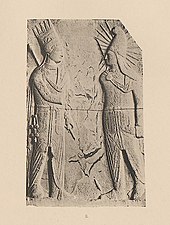Tiara (ancient times)

The tiara ( Greek τιάρα ) was a headgear in antiquity that was part of the typical clothing of the rulers in oriental states, including in the Persian and Achaemenid Empire , but was also worn by the military and the people. The term tiara is the Greek transcription of a probably Persian name.
Structure and appearance
The tiara is probably of Median origin and resembles the Phrygian cap . It is a tall, conical hat, round or pointed at the top, mostly made of felt or fur, with flaps on the ears and on the neck, which could be worn hanging down or tied up. The side flaps could also be tied under the chin or the beard, and they could also be tied over the mouth and nose for protection. On Achaemenid images, priests can be seen wearing such mouthguards during rituals, perhaps to protect sacred objects from human breath.
According to Herodotus , the king could only wear the cap in an upright position; all others, including satraps and high-ranking military men, wore the tip folded forward. The upper part was often decorated, as ornaments, for example, myrtle branches or oak leaves, simple disc or star patterns were also common. The ruler often wore a tiara around his forehead above the tiara, which was tied at the neck.
variants
The Persian tiara and its variations are characteristic of the people and gods depicted in the Persian regalia in the commagenic hierothesion on the Nemrut Dağı . John H. Young distinguishes four types of tiara there. First the Persian Tiara (Persian tiara) called by him , with the tip folded forward, which is worn here by gods, but also by early, Achaemenid great kings. The Pointed Tiara (pointed tiara) has an upright point and is shown in the later Persian ancestors of King Antiochus . The satrapial tiara (satrap tiara), the tip of which hangs flat forward to over the diadem, also occurs in later ancestors of the king. The Armenian Tiara (Armenian Tiara) is only worn by King Antiochus himself in Kommagene. In this species, the side and back flaps are tied up under the diadem, it ends at the top like a crown in five points and is decorated with lions, bundles of lightning, oak leaves or other floral patterns. This last type is also known from coins and as the headgear of the Armenian king Tigranes I and some of his descendants.
In some publications, tiara is also used as a name for the Persian crown Kidaris , also Kitaris, or for the Pileus des Mithras headgear, similar to the Phrygian cap .
Tigranes II with an Armenian tiara adorned with eagles
the Parthian King Vologaeses VI. with tiara
literature
- Eleonore Dörner : Deus Pileatus In: Jacques Duchesne-Guillemin (Ed.): Etudes mithriaques. Actes du 2e Congrès international, Téhéran, du 1er au 8 septembre 1975. Acta Iranica 17 , Leiden, Brill 1978, ISBN 9789004039025 , pp. 115-122.
- Hubertus von Gall : The headgear of the Persian regalia with the Achaemenids . In: Archäologische Mitteilungen aus Iran, Vol. 7, 1974, pp. 145–161.
- Rolf Hurschmann : Tiara. In: The New Pauly (DNP). Volume 12, Metzler, Stuttgart 2002, ISBN 3-476-01470-3 , Sp. 528.
- John H. Young: Commagenian Tiaras: Royal and Divine In: American Journal of Archeology Vol. 68, 1964, pp. 29-34 ( online ).
- Ingrid Loschek : Tiara (1). In: (dies.): Reclam's fashion and costume dictionary. 5th edition Reclam, Stuttgart 2005, ISBN 3-15-010577-3 , p. 481.
Web links
- Peter Calmeyer: Crown I . In: Ehsan Yarshater (Ed.): Encyclopædia Iranica (English, including references)
Individual evidence
- ^ Mary Boyce : A History of Zoroastrianism: Volume II: Under the Achaemenians . BRILL, 1982, ISBN 978-90-04-06506-2 , pp. 20 ( limited preview in Google Book search).
- ^ David Asheri: A Commentary on Herodotus . Oxford University Press, 2007, ISBN 0-19-814956-5 , pp. 168 ( limited preview in Google Book search).



